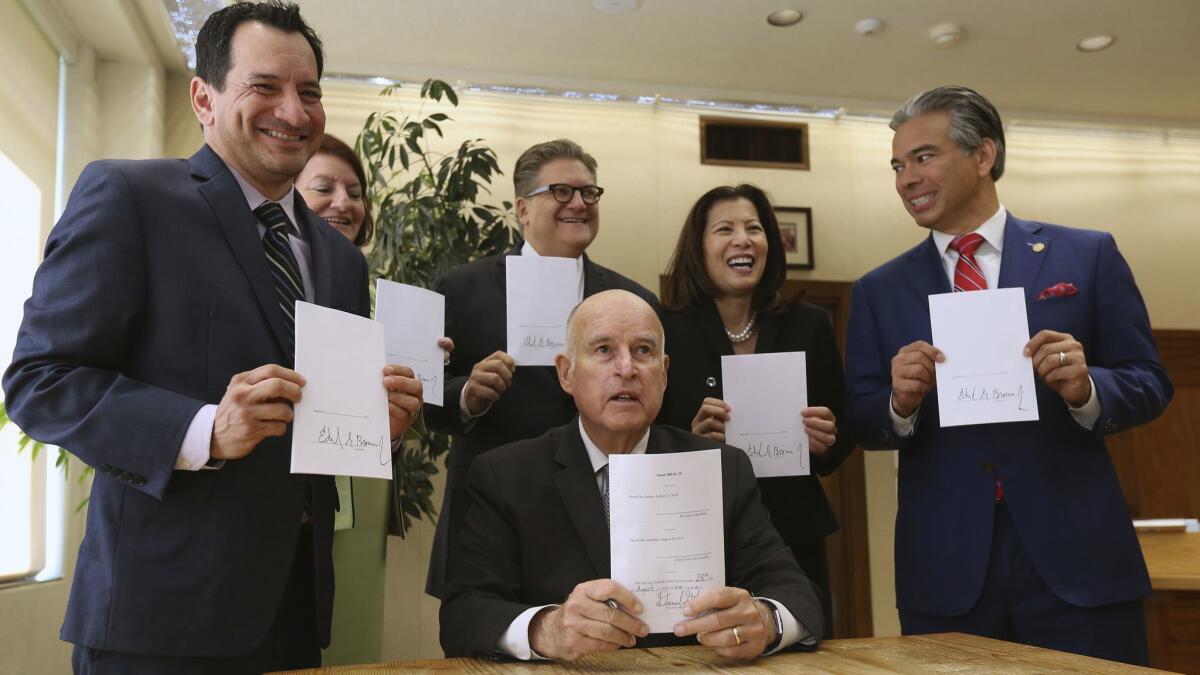Californiaâs chief justice says bail overhaul will continue with or without the new law

Reporting from San Francisco â California Chief Justice Tani Cantil-Sakauye on Tuesday defended a landmark new state law abolishing money bail, saying it was crafted to ensure courts âdo not judge a person based on the size of their wallet or what they have access to in someone elseâs wallet.â
In an annual meeting with reporters in San Francisco, the chief justice said the stateâs top court officials would continue to improve how judges determine whether criminal defendants are fit for release ahead of trial, even if the new law is suspended amid an effort from the bail industry to block it through a voter referendum.
âWe are seeking to make it as a fair and transparent as possible,â she said of the pretrial detention process. âWe as a branch supported [Senate Bill] 10 because we believed it was a fairer way to assess a person charged with a crime.â
The role of judges in the new pretrial system has been at the center of the debate over the new bail law signed by Gov. Jerry Brown in the final days of the 2018 legislative session.
SB 10, due to go in effect next October, was supposed to usher in one of the most sweeping criminal justice reforms of the governorâs administration. It would eliminate the practice of money bail, requiring counties to develop pretrial services agencies and so-called ârisk assessment tools,â or tech analyses, to determine which criminal defendants pose a threat to public safety or are at risk of not returning to court.
But some criminal justice and civil rights groups, including the American Civil Liberties Union of Northern California, found themselves in a difficult position after the final version of the bill was released: They supported the end of the cash bail system but moved to oppose the new law amid fears that it would grant judges too much power to put more people behind bars.
The new law has also come under attack from a coalition of bail industry groups, which see it as an existential threat to their industry and last month submitted more than enough signatures needed for a statewide referendum on the law in 2020. If election officials verify those signatures, the law could be put on hold until voters decide whether to overturn it.
Cantil-Sakauye, who helped develop the bail legislation, said Tuesday that she and other court officials understood the concerns from criminal justice reform advocates but argued that their intent was not to incarcerate more people. She said the use of risk assessment tools was meant to move courts away from cash bail to a process that focuses on an individualâs character and criminal history.
âWe are open to seeing how [bail reform] develops and going back to the drawing board,â she said. âBut we are committed to the fact that this is moving in the right direction.â
Cantil-Sakauye, a Republican appointed in 2010 by Gov. Arnold Schwarzenegger, will for the first time in her tenure head a Democratic-majority Supreme Court this year. She has long been a vocal critic of the stateâs bail system, which she has described as âoutdated, unsafe and unfair.â
Two years ago, she appointed a panel of 10 judges and one court executive officer to study the process for a year before they made a series of recommendations on how to fix the system. Their suggestions included eliminating fixed cash bail fees and were incorporated into the final version of the legislation.
Judicial Council Administrative Director Martin Hoshino said top court officials saw the new bail law as âa more holistic approachâ to move the entire state toward new pretrial systems that donât put such a significant financial burden on defendants. But many state courts had been moving in that direction long before the bill was introduced, he said.
Several court cases have changed how judges assign bail in a push to improve equal access to justice. As many as 49 California counties already use risk assessment tools, and courts in at least 11 counties are employing roughly 40 different pilot programs to reduce the number of people cycling in and out of jail.
Though the referendum would suspend some of the stateâs bail overhaul efforts until November 2020, âI donât think that forecloses our opportunity to build on the work that was already underway,â Hoshino said.
Meanwhile, a case up for review before the state Supreme Court could further alter a judgeâs authority to set bail. The court could drastically limit a judgeâs discretion to hold inmates indefinitely, a practice known as preventive detention, which criminal justice groups say would reduce most of their concerns with the state law.
Legislators are also discussing how to move forward with bail reform despite the referendum effort. On the first day of the 2019 legislative session, Sen. Bob Hertzberg (D-Van Nuys), coauthor of the bail overhaul bill signed by the governor, introduced another proposal that would require counties to report how they use the risk assessment tools in an effort to prevent improper and biased conclusions.
More stories from Jazmine Ulloa »
More to Read
Get the L.A. Times Politics newsletter
Deeply reported insights into legislation, politics and policy from Sacramento, Washington and beyond. In your inbox three times per week.
You may occasionally receive promotional content from the Los Angeles Times.











